Bony Defect Regeneration in Periodontitis: A Systematic Review of the Literature Regarding the Use of Enamel Matrix Derivative Proteins
Abstract
1. Introduction
- Suprabony (supracrestal or supra-alveolar) pockets appear when the bottom of the pocket is coronal to the crest of the alveolar bone, and the pocket wall lies coronal to the bone. This type of bone loss is always horizontal.
- Intrabony (infrabony, subcrestal, or intra-alveolar) pockets appear when the bottom of the pocket is apical to the crest of the alveolar bone. With this second type, the lateral pocket wall lies between the tooth surface and the alveolar bone. The bone loss is in most cases vertical.
2. Material and Methods
2.1. Search Method
- ➢
- “Emdogain intrabony defects”;
- ➢
- “Emdogain infrabony defects”.
2.2. Selection and Inclusion/Exclusion Criteria
- barrier membranes;
- grafting materials;
- growth factors/proteins.
2.3. Method of Screening
2.4. Data Extraction and Analysis
- -
- Distribution of study types.
2.5. Risk of Bias and Quality Control
3. Results
Summary Table of Articles from the Search Engine Databases
- -
- Distribution of the numbers of walls
- -
- Distribution of change in probing depth (PD).
- -
- Distribution of change in clinical attachment level (CAL).
4. Discussion
5. Conclusions
Supplementary Materials
Author Contributions
Funding
Institutional Review Board Statement
Informed Consent Statement
Conflicts of Interest
References
- Lang, N.P.; Bartold, P.M. Periodontal health. J. Clin. Periodontol. 2018, 45, 9–16. [Google Scholar] [CrossRef]
- Socransky, S.S.; Kaffajee, A.D.; Cugini, M.A.; Smith, C.; Kent, R.L., Jr. Microbial complexes in subgingival plaque. J. Clin. Periodontol. 1998, 25, 134–144. [Google Scholar] [CrossRef]
- Newman, M.G.; Carranza, F.A. Carranza’s Clinical Periodontology, 12th ed.; Elsevier/Saunders: St. Louis, MO, USA, 2015. [Google Scholar]
- Jayakumar, A.; Rohini, S.; Naveen, A.; Haritha, A.; Reddy, K. Horizontal alveolar bone loss: A periodontal orphan. J. Indian Soc. Periodontol. 2010, 14, 181–185. [Google Scholar] [CrossRef] [PubMed]
- Papapanou, P.N.; Sanz, M.; Buduneli, N.; Dietrich, T.; Feres, M.; Fine, D.H.; Flemmig, T.F.; Garcia, R.; Giannobile, W.V.; Graziani, F.; et al. Periodontitis: Consensus report of workgroup 2 of the 2017 World Workshop on the Classification of Periodontal and Peri-Implant Diseases and Conditions. J. Clin. Periodontol. 2018, 45, S162–S170. [Google Scholar] [CrossRef] [PubMed]
- Goldman, H.M.; Cohen, D.W. The Infrabony Pocket: Classification and Treatment. J. Periodontol. 1958, 29, 272–291. [Google Scholar] [CrossRef]
- Caton, J.G.; Armitage, G.; Berglundh, T.; Chapple, I.L.; Jepsen, S.; Kornman, K.S.; Mealey, B.L.; Papapanou, P.N.; Sanz, M.; Tonetti, M.S.; et al. A new classification scheme for periodontal and peri-implant diseases and conditions—Introduction and key changes from the 1999 classification. J. Periodontol. 2018, 89 (Suppl. 1), S1–S8. [Google Scholar] [CrossRef] [PubMed]
- Bosshardt, D.D. Biological mediators and periodontal regeneration: A review of enamel matrix proteins at the cellular and molecular levels. J. Clin. Periodontol. 2008, 35, 87–105. [Google Scholar] [CrossRef] [PubMed]
- Pilloni, A.; Saccucci, M.; Di Carlo, G.; Zeza, B.; Ambrosca, M.; Paolantonio, M.; Sammartino, G.; Mongardini, C.; Polimeni, A. Clinical Evaluation of the Regenerative Potential of EMD and NanoHA in Periodontal Infrabony Defects: A 2-Year Follow-Up. BioMed Res. Int. 2014, 2014, 492725. [Google Scholar] [CrossRef] [PubMed]
- Rasperini, G.; Acunzo, R.; Barnett, A.; Pagni, G. The soft tissue wall technique for the regenerative treatment of non-contained infrabony defects: A case series. Int. J. Periodontics Restor. Dent. 2013, 33, 79–87. [Google Scholar] [CrossRef] [PubMed]
- Eickholz, P.; Röllke, L.; Schacher, B.; Wohlfeil, M.; Dannewitz, B.; Kaltschmitt, J.; Krieger, J.K.; Krigar, D.M.; Reitmeir, P.; Kim, T. Enamel Matrix Derivative in Propylene Glycol Alginate for Treatment of Infrabony Defects With or Without Systemic Doxycycline: 12- and 24-Month Results. J. Periodontol. 2014, 85, 669–675. [Google Scholar] [CrossRef] [PubMed]
- Mueller, V.T.; Welch, K.; Bratu, D.C.; Wang, H.-L. Early and late studies of EMD use in periodontal intrabony defects. J. Periodont. Res. 2013, 48, 117–125. [Google Scholar] [CrossRef] [PubMed]
- Ghezzi, C.; Ferrantino, L.; Bernardini, L.; Lencioni, M.; Masiero, S. Minimally Invasive Surgical Technique in Periodontal Regeneration: A Randomized Controlled Clinical Trial Pilot Study. Int. J. Periodontics Restor. Dent. 2016, 36, 475–482. [Google Scholar] [CrossRef] [PubMed]
- Tonetti, M.S.; Greenwell, H.; Kornman, K.S. Staging and grading of periodontitis: Framework and proposal of a new classification and case definition. J. Periodontol. 2018, 89 (Suppl. S1), S159–S172. [Google Scholar] [CrossRef]
- Page, M.J.; McKenzie, J.E.; Bossuyt, P.M.; Boutron, I.; Hoffmann, T.C.; Mulrow, C.D.; Shamseer, L.; Tetzlaff, J.M.; Akl, E.A.; Brennan, S.E.; et al. The PRISMA 2020 statement: An updated guideline for reporting systematic reviews. BMJ 2021, 372, n71. [Google Scholar] [CrossRef] [PubMed]
- Chapple, I.L.C.; Mealey, B.L.; Van Dyke, T.E.; Bartold, P.M.; Dommisch, H.; Eickholz, P.; Geisinger, M.L.; Genco, R.J.; Glogauer, M.; Goldstein, M.; et al. Periodontal health and gingival diseases and conditions on an intact and a reduced periodontium: Consensus report of workgroup 1 of the 2017 World Workshop on the Classification of Periodontal and Peri-Implant Diseases and Conditions. J. Clin. Periodontol. 2018, 45, S68–S77. [Google Scholar] [CrossRef]
- Del Fabbro, M.; Karanxha, L.; Panda, S.; Bucchi, C.; Nadathur Doraiswamy, J.; Sankari, M.; Ramamoorthi, S.; Varghese, S.; Taschieri, S. Autologous platelet concen-trates for treating periodontal infrabony defects. Cochrane Database Syst. Rev. 2018, 11, CD011423. [Google Scholar] [CrossRef]
- Ragghianti Zangrando, M.S.; Chambrone, D.; Pasin, I.M.; Conde, M.C.; Pannuti, C.M.; de Lima, L.A.P.A. Two-year randomized clinical trial of enamel matrix derivative treated infrabony defects: Radiographic analysis. BMC Oral Health 2014, 14, 149. [Google Scholar] [CrossRef] [PubMed]
- Losada, M.; González, R.; Garcia, À.P.; Santos, A.; Nart, J. Treatment of Non-Contained Infrabony Defects With Enamel Matrix Derivative Alone or in Combination With Biphasic Calcium Phosphate Bone Graft: A 12-Month Randomized Controlled Clinical Trial. J. Periodont. 2017, 88, 426–435. [Google Scholar] [CrossRef] [PubMed]
- Nickles, K.; Dannewitz, B.; Gallenbach, K.; Ramich, T.; Scharf, S.; Röllke, L.; Schacher, B.; Eickholz, P. Long-Term Stability After Regenerative Treatment of Infrabony Defects: A Retrospective Case Series. J. Periodontol. 2017, 88, 536–542. [Google Scholar] [CrossRef]
- Miron, R.J.; Zhang, Q.; Sculean, A.; Buser, D.; Pippenger, B.E.; Dard, M.; Shirakata, Y.; Chandad, F.; Zhang, Y. Osteoinductive potential of 4 commonly employed bone grafts. Clin. Oral Investig. 2016, 20, 2259–2265. [Google Scholar] [CrossRef] [PubMed]
- Szatmári, P.; Gera, I. Treatment of localized intrabony periodontal defects with enamel matrix derivative (Emdogain). Case series. Fogorv. Sz. 2014, 107, 15–28. [Google Scholar]
- Fileto Mazzonetto, A.L.; Casarin, R.C.V.; Santamaria, M.P.; Andere, N.M.R.B.; Araújo, C.F.; Videira Clima da Silva, R.; Purisaca, J.E.V.; Sallum, E.A.; Sallum, A.W. Clinical, radiographic, and patient-centered outcomes after use of enamel matrix proteins for the treatment of intrabony defects in patients with aggressive periodontitis: A 12-month multicenter clinical trial. J. Periodont. 2021, 92, 995–1006. [Google Scholar] [CrossRef] [PubMed]
- Machot, E.; Hoffmann, T.; Lorenz, K.; Khalili, I.; Noack, B. Clinical Outcomes after Treatment of Periodontal Intrabony Defects with Nanocrystalline Hydroxyapatite (Ostin) or Enamel Matrix Derivatives (Emdogain): A Randomized Controlled Clinical Trial. BioMed Res. Int. 2014, 2014, 786353. [Google Scholar] [CrossRef] [PubMed]
- Rojas, M.A.; Marini, L.; Pilloni, A.; Sahrmann, P. Early wound healing outcomes after regenerative periodontal surgery with enamel matrix derivatives or guided tissue regeneration: A systematic review. BMC Oral Health 2019, 19, 76. [Google Scholar] [CrossRef] [PubMed]
- Stavropoulos, A.; Bertl, K.; Spineli, L.M.; Sculean, A.; Cortellini, P.; Tonetti, M. Medium- and long-term clinical benefits of periodontal regenerative/reconstructive procedures in intrabony defects: Systematic review and network meta-analysis of randomized controlled clinical studies. J. Clin. Periodont. 2021, 48, 410–430. [Google Scholar] [CrossRef] [PubMed]
- Gupta, S.J.; Jhingran, R.; Gupta, V.; Bains, V.K.; Madan, R.; Rizvi, I. Efficacy of platelet-rich fibrin vs. enamel matrix derivative in the treatment of periodontal intrabony defects: A clinical and cone beam computed tomography study. J. Int. Acad. Periodontol. 2014, 16, 86–96. [Google Scholar]
- Matarasso, M.; Iorio-Siciliano, V.; Blasi, A.; Ramaglia, L.; Salvi, G.E.; Sculean, A. Enamel matrix derivative and bone grafts for periodontal regeneration of intrabony defects. A systematic review and meta-analysis. Clin. Oral Investig. 2015, 19, 1581–1593. [Google Scholar] [CrossRef] [PubMed]
- Corbella, S.; Alberti, A.; Calciolari, E.; Taschieri, S.; Francetti, L. Enamel matrix derivative for the treatment of partially contained intrabony defects: 12-month results. Aust. Dent. J. 2019, 64, 27–34. [Google Scholar] [CrossRef] [PubMed]
- Aslan, S.; Buduneli, N.; Cortellini, P. Clinical outcomes of the entire papilla preservation technique with and without biomaterials in the treatment of isolated intrabony defects: A randomized controlled clinical trial. J. Clin. Periodont. 2020, 47, 470–478. [Google Scholar] [CrossRef] [PubMed]
- Pietruska, M.; Pietruski, J.; Nagy, K.; Brecx, M.; Arweiler, N.B.; Sculean, A. Four-year results following treatment of intrabony periodontal defects with an enamel matrix derivative alone or combined with a biphasic calcium phosphate. Clin. Oral Investig. 2012, 16, 1191–1197. [Google Scholar] [CrossRef] [PubMed]
- Koop, R.; Merheb, J.; Quirynen, M. Periodontal Regeneration with Enamel Matrix Derivative in Reconstructive Periodontal Therapy: A Systematic Review. J. Periodont. 2012, 83, 707–720. [Google Scholar] [CrossRef] [PubMed]
- Li, W.; Xiao, L.; Hu, J. The use of enamel matrix derivative alone versus in combination with bone grafts to treat patients with periodontal intrabony defects: A meta-analysis. J. Am. Dent. Assoc. 2012, 143, e46–e56. [Google Scholar] [CrossRef]
- Döri, F.; Arweiler, N.B.; Szántó, E.; Ágics, A.; Gera, I.; Sculean, A. Ten-Year Results Following Treatment of Intrabony Defects With an Enamel Matrix Protein Derivative Combined With Either a Natural Bone Mineral or a β-Tricalcium Phosphate. J. Periodont. 2013, 84, 749–757. [Google Scholar] [CrossRef]
- Iorio-Siciliano, V.; Andreuccetti, G.; Blasi, A.; Matarasso, M.; Sculean, A.; Salvi, G.E. Clinical outcomes following regenerative therapy of non-contained intrabony defects using a deproteinized bovine bone mineral combined with either enamel matrix derivative or collagen membrane. J. Periodontol. 2014, 85, 1342–1350. [Google Scholar] [CrossRef] [PubMed]
- Parashis, A.O.; Polychronopoulou, A.; Tsiklakis, K.; Tatakis, D.N. Enamel Matrix Derivative in Intrabony Defects: Prognostic Parameters of Clinical and Radiographic Treatment Outcomes. J. Periodont. 2012, 83, 1346–1352. [Google Scholar] [CrossRef]
- Ferrarotti, F.; Romano, F.; Quirico, A.; Di Bella, M.; Pallotti, S.; Aimetti, M. Effectiveness of Enamel Matrix Derivative in Conjunction with Particulate Autologous Bone in the Treatment of Noncontained Intrabony Defects: A 2-Year Prospective Case Series. Int. J. Periodontics. Restor. Dent. 2018, 38, 673–680. [Google Scholar] [CrossRef] [PubMed]
- Miron, R.J.; Wei, L.; Bosshardt, D.D.; Buser, D.; Sculean, A.; Zhang, Y. Effects of enamel matrix proteins in combination with a bovine-derived natural bone mineral for the repair of bone defects. Clin. Oral Investig. 2014, 18, 471–478. [Google Scholar] [CrossRef] [PubMed]
- Bertoldi, C.; Labriola, A.; Generali, L. Dental root surface treatment with ethylenediaminetetraacetic acid does not improve enamel matrix derivative peptide treatment within intrabony defects: A retrospective study. J. Biol. Regul. Homeost. Agents 2019, 33, 1945–1947. [Google Scholar] [CrossRef] [PubMed]
- Hoffmann, T.; Al-Machot, E.; Meyle, J.; Jervøe-Storm, P.-M.; Jepsen, S. Three-year results following regenerative periodontal surgery of advanced intrabony defects with enamel matrix derivative alone or combined with a synthetic bone graft. Clin. Oral Investig. 2016, 20, 357–364. [Google Scholar] [CrossRef] [PubMed]
- Trombelli, L.; Farina, R.; Vecchiatini, R.; Maietti, E.; Simonelli, A. A simplified composite outcome measure to assess the effect of periodontal regenerative treatment in intraosseous defects. J. Periodont 2020, 91, 723–731. [Google Scholar] [CrossRef] [PubMed]
- Liu, Y.; Duan, D.; Xin, Y.; Bai, L.; Li, T.; Li, C.; Xu, Y. A review of the literature: Antibiotic usage and its relevance to the infection in periodontal flaps. Acta Odontol. Scand. 2017, 75, 288–293. [Google Scholar] [CrossRef] [PubMed]
- Döri, F.; Arweiler, N.; Húszár, T.; Gera, I.; Miron, R.J.; Sculean, A. Five-Year Results Evaluating the Effects of Platelet-Rich Plasma on the Healing of Intrabony Defects Treated With Enamel Matrix Derivative and Natural Bone Mineral. J. Periodont. 2013, 84, 1546–1555. [Google Scholar] [CrossRef] [PubMed]
- Agrali, O.; Kuru, B.E.; Yarat, A.; Kuru, L. Evaluation of gingival crevicular fluid transforming growth factor-β1 level after treatment of intrabony periodontal defects with enamel matrix derivatives and autogenous bone graft: A randomized controlled clinical trial. Nig. J. Clin. Pract. 2016, 19, 535. [Google Scholar] [CrossRef] [PubMed]
- Aimetti, M.; Ferrarotti, F.; Mariani, G.M.; Romano, F. A novel flapless approach versus minimally invasive surgery in periodontal regeneration with enamel matrix derivative proteins: A 24-month randomized controlled clinical trial. Clin. Oral Investig. 2017, 21, 327–337. [Google Scholar] [CrossRef] [PubMed]
- Mitani, A.; Takasu, H.; Horibe, T.; Furuta, H.; Nagasaka, T.; Aino, M.; Fukuda, M.; Fujimura, T.; Mogi, M.; Noguchi, T. Five-year clinical results for treatment of intrabony defects with EMD, guided tissue regeneration and open-flap debridement: A case series. J. Periodont. Res. 2014, 50, 123–130. [Google Scholar] [CrossRef] [PubMed]
- Aydemir Turkal, H.; Demirer, S.; Dolgun, A.; Keceli, H.G. Evaluation of the adjunctive effect of platelet-rich fibrin to enamel matrix derivative in the treatment of intrabony defects. Six-month results of a randomized, split-mouth, controlled clinical study. J. Clin. Periodont. 2016, 43, 955–964. [Google Scholar] [CrossRef]
- Anoixiadou, S.; Parashis, A.; Vouros, I. Enamel matrix derivative as an adjunct to minimally invasive non-surgical treatment of intrabony defects: A randomized clinical trial. J. Clin. Periodont. 2022, 49, 134–143. [Google Scholar] [CrossRef]
- Ogihara, S.; Tarnow, D.P. Efficacy of Enamel Matrix Derivative With Freeze-Dried Bone Allograft or Demineralized Freeze-Dried Bone Allograft in Intrabony Defects: A Randomized Trial. J. Periodontol. 2014, 85, 1351–1360. [Google Scholar] [CrossRef] [PubMed]
- Aslan, S.; Buduneli, N.; Cortellini, P. Entire papilla preservation technique in the regenerative treatment of deep intrabony defects: 1-Year results. J. Clin. Periodont. 2017, 44, 926–932. [Google Scholar] [CrossRef]
- Bhutda, G.; Deo, V. Five years clinical results following treatment of human intra-bony defects with an enamel matrix derivative: A randomized controlled trial. Acta Odontol. Scand. 2013, 71, 764–770. [Google Scholar] [CrossRef] [PubMed]
- Scaffold Requirements for Periodontal Regeneration with Enamel Matrix Derivative Proteins. PubMed. Available online: https://pubmed.ncbi.nlm.nih.gov/28531879/ (accessed on 13 June 2024).
- Aimetti, M.; Ferrarotti, F.; Mariani, G.; Fratini, A.; Giraudi, M.; Romano, F. Enamel Matrix Derivative Proteins in Combination with a Flapless Approach for Periodontal Regeneration of Intrabony Defects: A 2-Year Prospective Case Series. Int. J. Periodont. Restor. Dent. 2016, 36, 797–805. [Google Scholar] [CrossRef] [PubMed]
- Wang, Y.; Zhang, Y.; Jing, D.; Shuang, Y.; Miron, R.J. Enamel matrix derivative improves gingival fibroblast cell behavior cultured on titanium surfaces. Clin. Oral Investig. 2016, 20, 685–695. [Google Scholar] [CrossRef] [PubMed]
- Clinical and CBCT Evaluation of Combined Periodontal Regenerative Therapies Using Enamel Matrix Derivative and Deproteinized Bovine Bone Mineral With or Without Collagen Membrane. Available online: http://quintpub.com/journals/prd/abstract.php?iss2_id=1525&article_id=18331#.YpI_RXXP1PY (accessed on 28 May 2024).
- De Leonardis, D.; Paolantonio, M. Enamel Matrix Derivative, Alone or Associated With a Synthetic Bone Substitute, in the Treatment of 1- to 2-Wall Periodontal Defects. J. Periodontol. 2013, 84, 444–455. [Google Scholar] [CrossRef] [PubMed]
- Miron, R.J.; Sculean, A.; Cochran, D.L.; Froum, S.; Zucchelli, G.; Nemcovsky, C.; Donos, N.; Lyngstadaas, S.P.; Deschner, J.; Dard, M.; et al. Twenty years of enamel matrix derivative: The past, the present and the future. J. Clin. Periodontol. 2016, 43, 668–683. [Google Scholar] [CrossRef] [PubMed]
- de Sanctis, M.; Goracci, C.; Zucchelli, G. Long-term effect on tooth vitality of regenerative therapy in deep periodontal bony defects: A retrospective study. Int. J. Periodont. Restor. Dent. 2013, 33, 151–157. [Google Scholar] [CrossRef] [PubMed]
- Mikami, R.; Mizutani, K.; Shioyama, H.; Matsuura, T.; Aoyama, N.; Suda, T.; Kusunoki, Y.; Takeda, K.; Izumi, Y.; Aida, J.; et al. Influence of aging on periodontal regenerative therapy using enamel matrix derivative: A 3-year prospective cohort study. J. Clin. Periodontol. 2021, 49, 123–133. [Google Scholar] [CrossRef] [PubMed]
- Artzi, Z.; Tal, H.; Platner, O.; Wasersprung, N.; Weinberg, E.; Slutzkey, S.; Gozali, N.; Carmeli, G.; Herzberg, R.; Kozlovsky, A. Deproteinized bovine bone in association with guided tissue regeneration or enamel matrix derivatives procedures in aggressive periodontitis patients: A 1-year retrospective study. J. Clin. Periodontol. 2015, 42, 547–556. [Google Scholar] [CrossRef] [PubMed]
- Sculean, A.; Nikolidakis, D.; Nikou, G.; Ivanovic, A.; Chapple, I.L.C.; Stavropoulos, A. Biomaterials for promoting periodontal regeneration in human intrabony defects: A systematic review. Periodontol. 2000 2015, 68, 182–216. [Google Scholar] [CrossRef]
- Stavropoulos, A.; Bertl, K.; Sculean, A.; Kantarci, A. Regenerative Periodontal Therapy in Intrabony Defects and Long-Term Tooth Prognosis. Dent. Clin. N. Am. 2022, 66, 103–109. [Google Scholar] [CrossRef]
- University of Bern. Effect of Emdogain on Wound Healing After Gingival Recession Coverage Using Connective Tissue Graft: A Pilot Study 2017. Available online: https://pubmed.ncbi.nlm.nih.gov/31290017/ (accessed on 20 June 2024).
- NCT02810054; Using MIST With or Without EMD in Treatment of Intrabony Periodontal Defects. The University of Manchester: Manchester, UK, 2018. Available online: https://clinicaltrials.gov/study/NCT02810054 (accessed on 15 May 2024).
- NCT05029089; Modified Entire Papilla Preservation Technique for Treatment of Intrabony Defects. Medical University of Warsaw: Warszawa, Poland, 2021. Available online: https://clinicaltrials.gov/study/NCT05029089 (accessed on 21 May 2024).
- Lee, J.H.; Kim, D.H.; Jeong, S.N. Adjunctive Use of Enamel Matrix Derivatives to Porcine Derived Xenograft for the Treatment of One-Wall Intrabony Defects: Two-Year Longitudinal Results of a Randomized Controlled Clinical Trial. J. Periodontol. 2019, 91, 880–889. [Google Scholar] [CrossRef]
- JPRN-UMIN000008231; A Non-Inferiority Study Evaluating Fibroblast Growth Factor-2 (KCB-1D) to Enamel Matrix Derivative (Emdogain(R)Gel) for Periodontal Tissue Regeneration. Ogawa Red Cross Hospital: Saitama, Japan, 2019. Available online: https://trialsearch.who.int/Trial2.aspx?TrialID=JPRN-UMIN000008231 (accessed on 20 June 2024).
- IRCT2017022716141N3; Comparative Evaluation of Two Different Regenerative Materials in Reconstruction of Periodontal Defects. Hamedan University of Medical Sciences: Hamedan, Iran, 2018. Available online: https://trialsearch.who.int/Trial2.aspx?TrialID=IRCT2017022716141N3 (accessed on 10 June 2024).
- ISRCTN18159776; Treatment of Peri-Implant Diseases with Enamel Matrix Proteins. ThinkingPerio Research: Bilbao, Spain, 2021. Available online: https://trialsearch.who.int/Trial2.aspx?TrialID=ISRCTN18159776 (accessed on 10 June 2024).

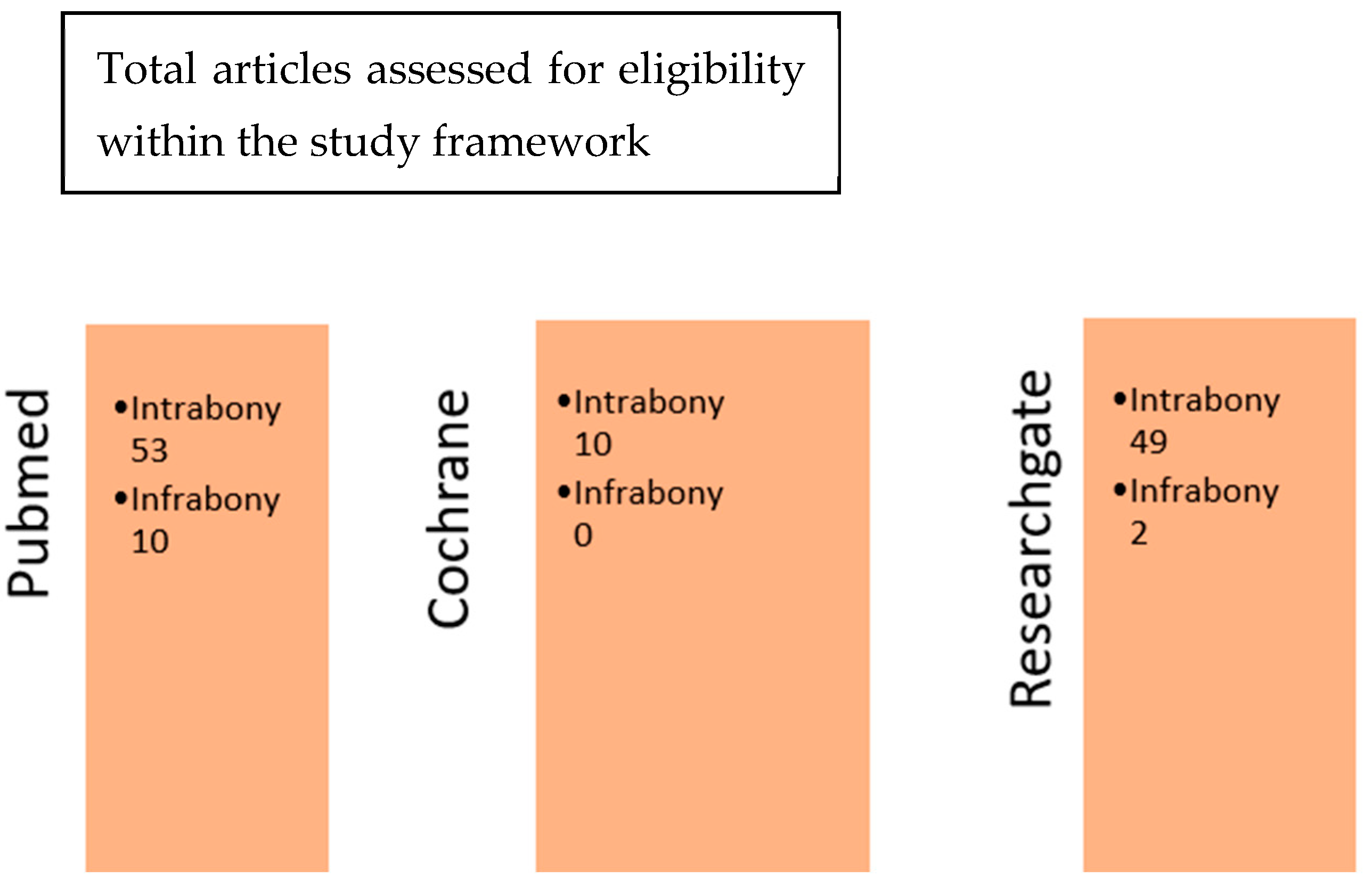
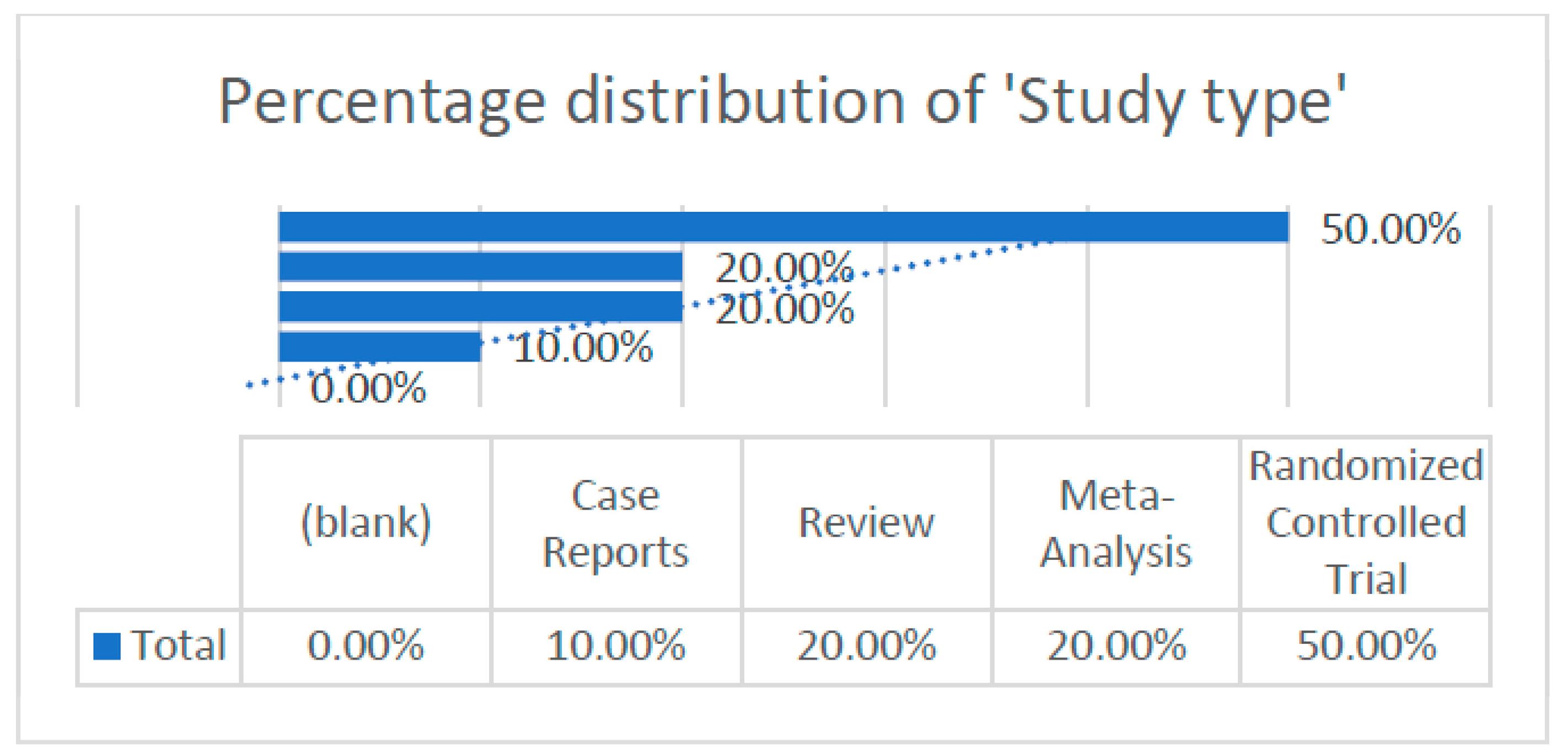

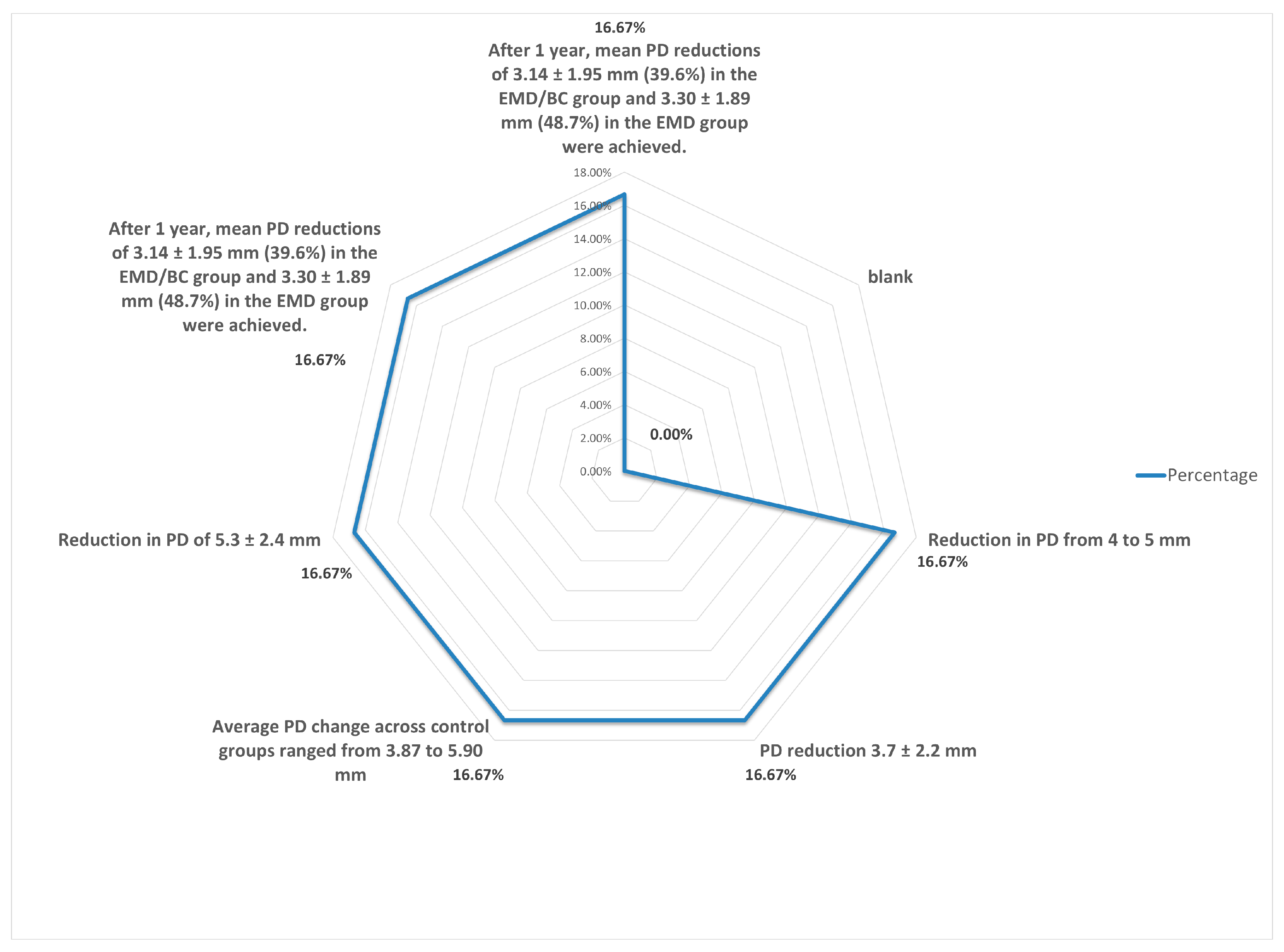

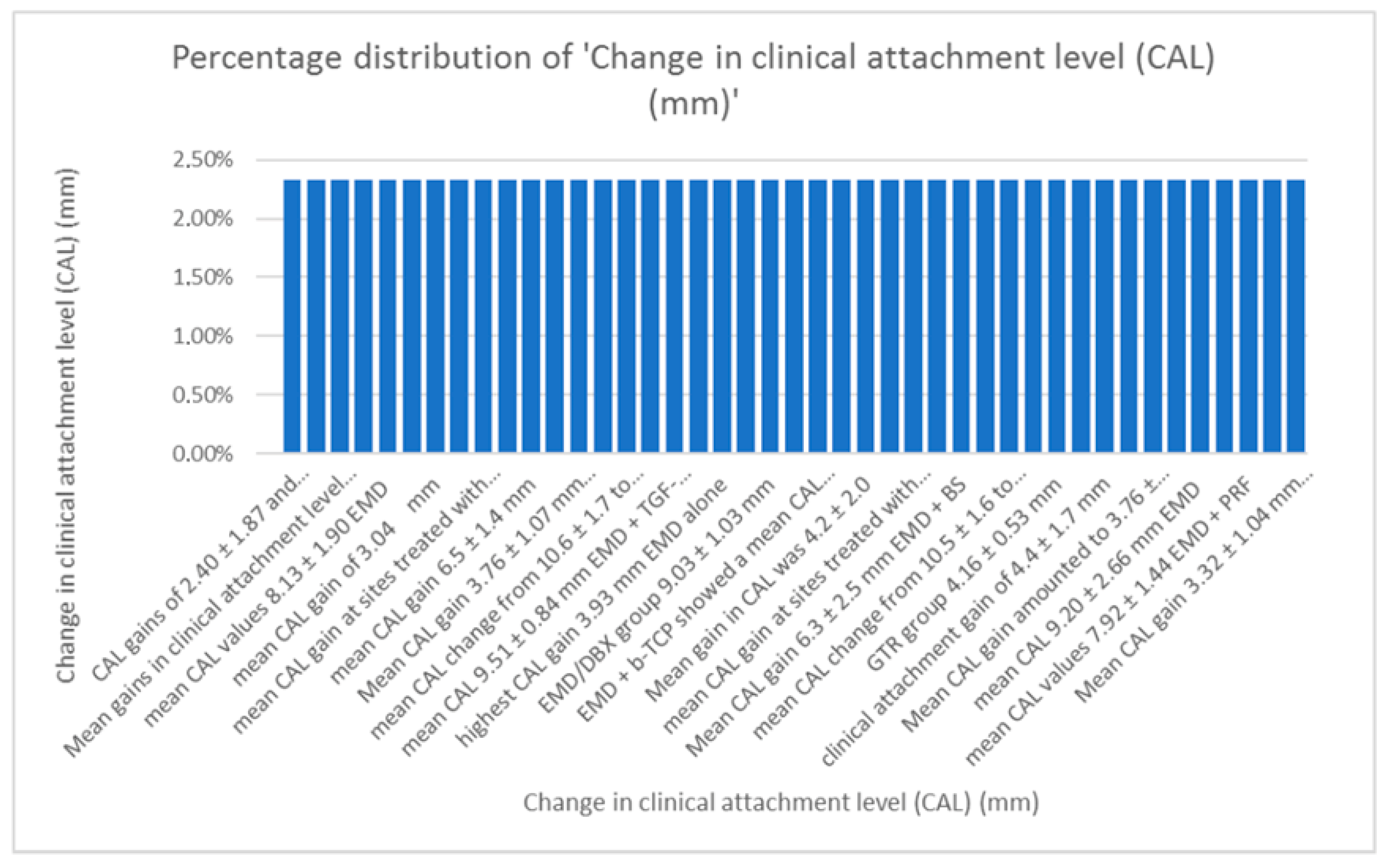
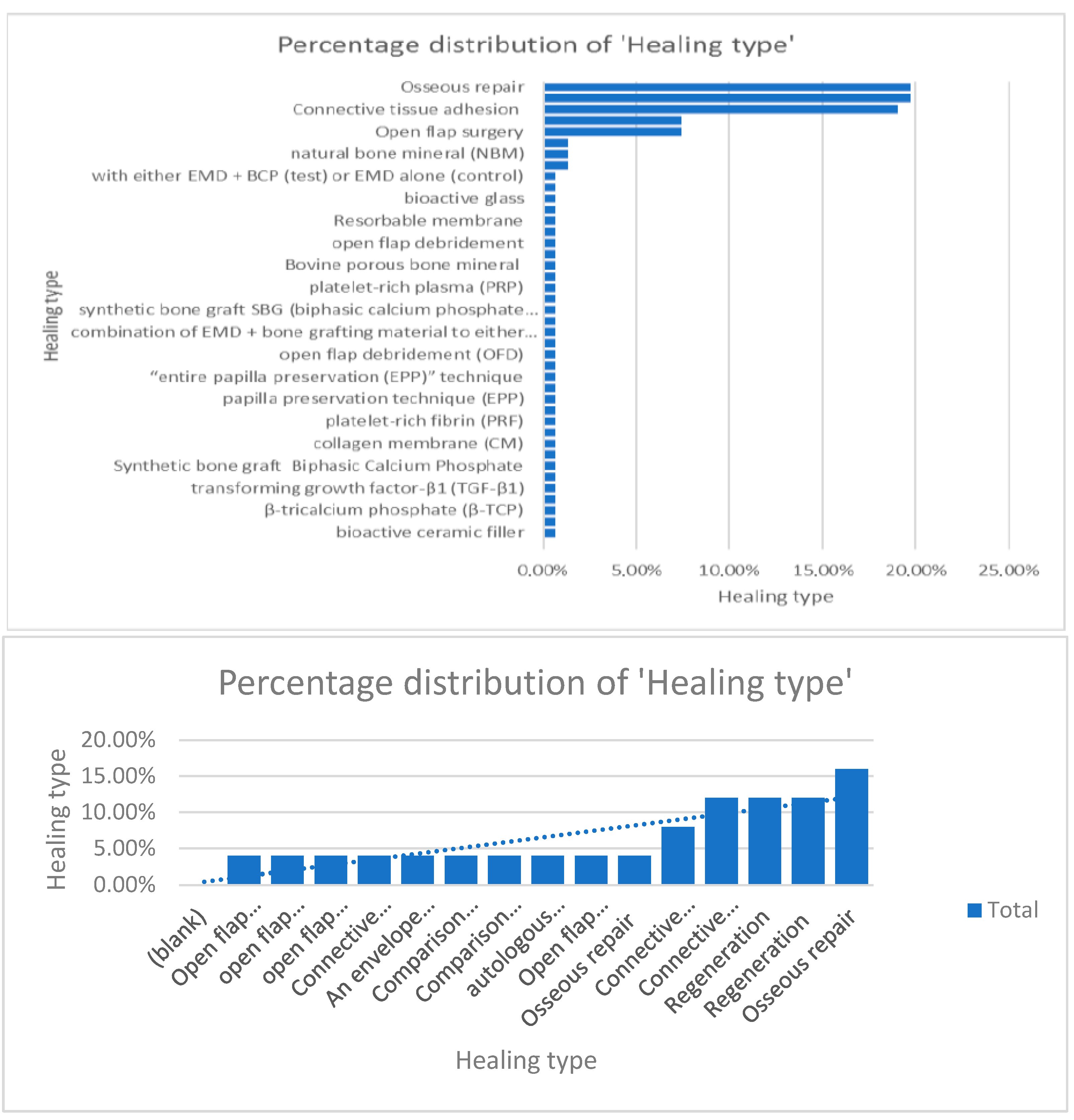
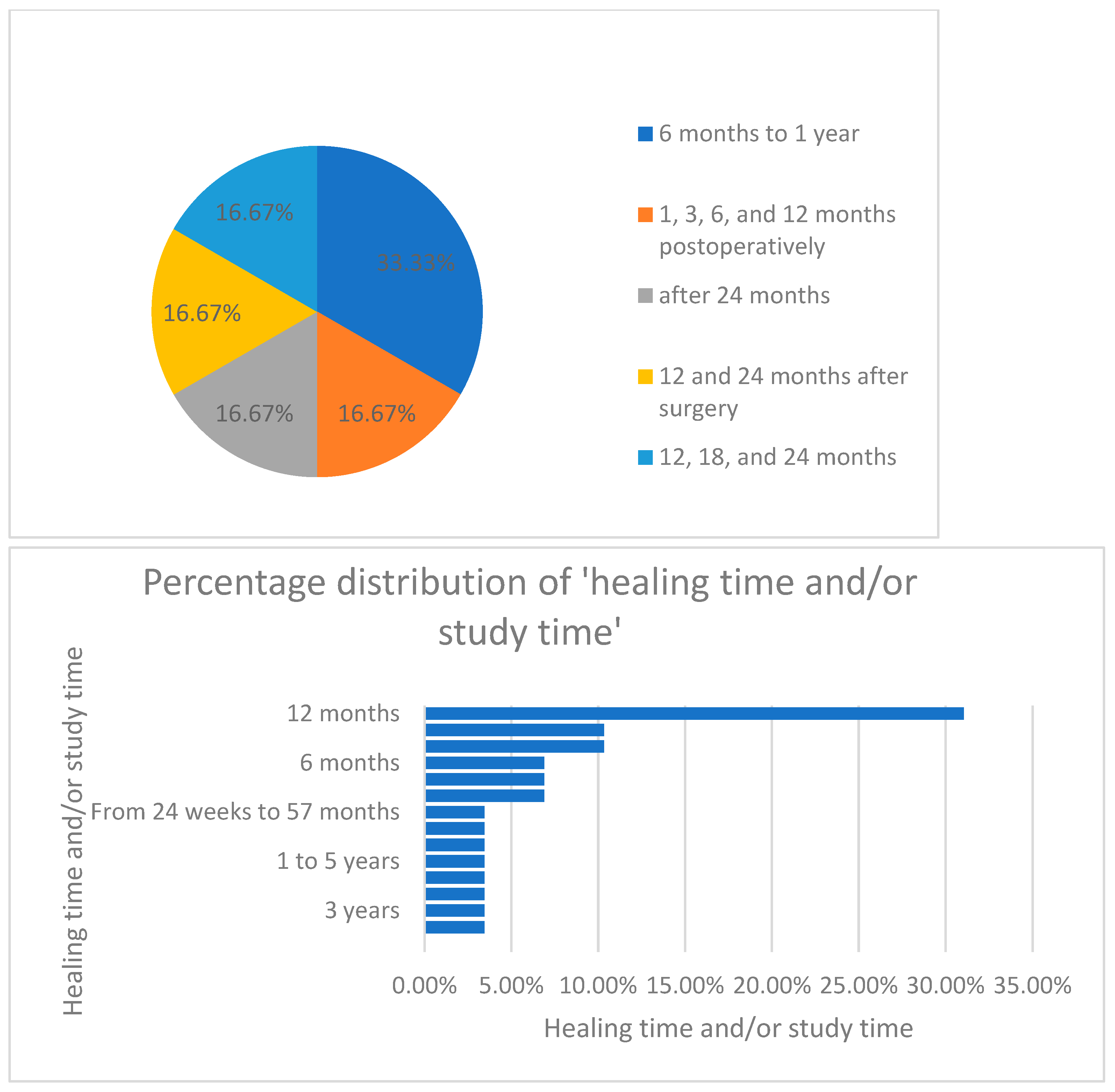
| MeSH Keywords | Inclusion Criteria | Exclusion Criteria |
|---|---|---|
| Emdogain intrabony defects | Studies relevant to the review objectives: intrabony/infrabony defects | Studies involving animal subjects |
| Emdogain infrabony defects | Studies of adult patients covering all age groups | Seminar presentations/case reports and case studies |
| Bone regeneration | Randomized/non-randomized investigations and clinical trials | Opinion pieces |
| Tissue regeneration | Clinical cases of at least 10 patients | Incomplete or missing data |
| Validated comparative analyses and reviews | Conference presentations and abstracts | |
| Papers written in English | Non-English-language articles |
| Study Authors (Ref. No.) | Year of Publication | Study Type | No. of Patients | No. of Defects | Wall(s) | Defect Depth (mm) | Healing Time and/or Study Time | Healing Type | Conclusions | Change in Probing Depth PD (mm) | Change in Clinical Attachment Level CAL (mm) |
|---|---|---|---|---|---|---|---|---|---|---|---|
| Pilloni et al. [9] | 2014 | Review | 64 patients | 1, 2, and/or 3 walls | Intrabony defect more than 3 mm on radiograph with PD ≥ 5 mm | 12, 18, and 24 months | Regeneration Connective tissue adhesion Osseous repair Open-flap debridement + EMD | EMD + nano-HA synergic role | Reduction in PD of 5.3 ± 2.4 mm | CAL average gain of 4.7 mm ± 2.5 mm | |
| Eickholz et al. [11] | 2014 | Randomized control trial | 61 patients | 57 defects | 1, 2, and/or 3 walls | Infrabony defect depth ≥ 4 mm | 12 and 24 months after surgery | Osseous repair Regeneration Open-flap Comparison EMD + Doxy versus EMD alone | 200 mg Doxy for 7; no improvement in PD nor in CAL | PD reduction of 3.7 ± 2.2 mm | CAL gain of 4.7 ± 1.93 mm |
| Del Fabbro et al. [17] | 2018 | Meta-analysis | 1402 defects | 2 and/or 3 walls | Infrabony defect depth ≥ 3–6 mm | 6 months to 1 year | APC + EMD vs. EMD Regeneration OFD Osseous repair | No advantages of APC + EMD | Average PD from 5.9 mm to 3.7 mm | ||
| Ragghianti Zangrando et al. [18] | 2014 | Randomized control trial | 10 patients | 43 defects | 2 and/or 3 walls | Infrabony defect ≥ 3 mm | After 24 months | OFD OFD + EMD Connective tissue adhesion | No clear results | Reduction of 4.21 ± 0.97 mm in PD average | CAL average gain of 5.69 ± 1.96 mm |
| Losada et al. [19] | 2017 | Randomized control trial | 52 patients | 46 defects | 1 and/or 2 walls | Infrabony defect ≥ 3 mm | 1, 3, 6, and 12 months after surgery | Regeneration Connective tissue adhesion Envelope full thickness flap | Statistically significant PD reduction and CAL gain | PD reduction of 3.14 ± 1.95 mm | CAL gain of 2.38 ± 2.17 mm |
| Nikcles et al. [20] | 2017 | Review | 47 patients | 41 defects | 1, 2, and/or 3 walls | 6 months to 1 year | Regeneration Osseous repair Connective tissue adhesion | Regenerative therapy had better results than OFD | Reduction in PD from 5 mm to 4 mm | 3 mm CAL gain after 12 months | |
| Miron RJ et al. [21] | 2016 | Review | 434 patients | 1, 2, and/or 3 walls | Infrabony defect ≥ 3–6 mm | 6 to 12 months | Regeneration OFD Osseous repair | Histological genuine regeneration | Mean PD reduction of 4.22 ± 1.2 mm | CAL gain of 3.76 ± 1.07 mm | |
| Fileto Mazzonetto et al. [22] | 2021 | Randomized control trial | 100 patients | 60 defects | 1, 2, and/or 3 walls | Infrabony defect ≥ 3–6 mm | 12 months | Simplified papilla preservation flap Regeneration Osseous repair | Statistically significant PD reduction and CAL gain | Mean PD reduction of 4.22 ± 1.2 mm | CAL gain of 3.76 ± 1.07 mm |
| Machot et al. [22] | 2014 | Randomized control trial | 38 patients | 1, 2, and/or 3 walls | Width ≥ 2 mm and depth ≥ 4 mm | 6 to 12 months | EMD + NHA Regeneration | More studies are required to prove potential advantages | PD reduction from 5 mm to 4 mm | CAL gain of 4.2 mm ± 2 mm | |
| Rojas et al. [25] | 2019 | Randomized control trial | 199 patients | 220 defects | 1, 2, and/or 3 walls | Infrabony defect ≥ 3 mm deep | 12 months | Comparison EMD vs. GTR | No clear advantages | PD reduction of 3.4 ± 1.2 mm | CAL gain of 4.4 ± 1.7 mm |
| Matarasso et al. [28] | 2015 | Review | 434 patients | 548 defects | 1, 2, and/or 3 walls | Infrabony defect ≥ 3 mm deep | 6, 8, and 12 months | EMD ± bone graft | EMD + bone graft better results than EMD alone | Mean PD reduction of 4.22 ± 1.2 mm | CAL gain of 3.76 ± 1.07 mm |
| Corbella et al. [29] | 2019 | Randomized control trial | 9 patients | 20 defects | 2 walls | 12 months | EMD + bovine-derived bone substitutes | No clear results | PD reduction of 3 ± 0.7 mm | CAL gain of 6.9 ± 1.1 mm | |
| Aslan et al. [30] | 2020 | Randomized control trial | 30 patients | 52 defects | 1, 2, and/or 3 walls | 12 months | EMD + bovine-derived bone substitutes | No statistically significant results | PD reduction of 6.5 ± 2.65 mm | CAL gain of 6.3 ± 2.5 mm | |
| Pietruska et al. [31] | 2012 | Randomized control trial | 24 patients | 1, 2, and/or 3 walls | 12 months | EMD+ BCP vs. EMD alone | No clear results | PD reduction of 4.7 ± 0.8 mm | CAL gain of 10.4 ± 1.3 mm | ||
| Koop et al. [32] | 2012 | Review | 1, 2, and/or 3 walls | Intrabony defect 3 to 4 mm deep | 12 months | Bovine porous bone mineral Bioactive glass EMD Bioactive ceramic filler | EMD more effective than controls | EMD superior to OFD with 1.52 mm | CAL gain compared to control: 1.3 mm | ||
| Dori et al. [34] | 2013 | Randomized control trial | 22 patients | 32 defects | 2 and/or 3 wall defects | 12 months | EMD + natural bone mineral/ β TCP | Results can be sustained over 10 years | |||
| Iorio-Siciliano et al. [35] | 2014 | Randomized control trial | 40 patients | 40 defects | 1, 2, and/or 3 walls | Intrabony depth ≥3 mm | 12 months | EMD + deproteinized bovine bone mineral/ collagen membrane | Similar results at 12 months | ||
| Parashis et al. [36] | 2012 | Randomized control trial | 61 patients | 61 defects | 2 and/or 3 walls | Intrabony depth ≥ 4 mm | 12 months | OFD Regeneration Osseous repair | Statistically significant improvement | PD reduction of 3.9 ± 1 mm | CAL gain of 6.5 ± 1.4 mm |
| Mueller et al. [12] | 2013 | Meta-analysis | 1, 2, and/or 3 walls | Intrabony depth ≥ 3 mm | 12 months | Regeneration Connective tissue adhesion Osseous repair | Significant results when using EMD | Mean PD reduction of 4.05 mm | Mean CAL gain of 3.04 mm | ||
| Bertoldi et al. [39] | 2019 | Review | 22 patients | 42 defects | 1, 2, and/or 3 walls | Intrabony depth ≥ 3 mm | 12 months | Regeneration Connective tissue adhesion Osseous repair | Significant results when using EMD at 1 and 2 years | PD reduction of 3.3 mm at 1 year and 3.4 mm at 2 years | CAL gain of 2.9 mm at 1 and 2 years |
| Hoffmann et al. [40] | 2016 | Randomized control trial | 30 patients | 30 defects | 1, 2, and/or 3 walls | Intrabony depth ≥ 3 mm | 6, 12, and 36 months | Regeneration EMD ± BCP | No discernible benefit | PD reduction of 3.93 mm | CAL gain of 3.8 ± 2.2 mm |
| Trombelli et al. [41] | 2021 | Meta-analysis | 10 patients/study | 10 defects/study | 1, 2, and/or 3 walls | Intrabony depth ≥ 3 mm | 12 months | Bone graft Regeneration Osseous repair | EMD + bone graft shows more discernible results than EMD alone | Residual PD EMD + graft 4.32 mm | CAL gain from 3.65 to 4.1 mm |
| Dori et al. [43] | 2013 | Randomized control trial | 24 patients | 36 defects | 3, 6, and 12 months | EMD+ natural bone mineral/ Platelet-rich plasma | PRP does not appear to improve results | PD reduction of 8.7 ± 1.7 mm | CAL from 10.5 ± 1.6 mm to 6 ± 1.7 mm | ||
| Agrali et al. [44] | 2016 | Randomized control trial | 12 patients | 30 defects | 2 and/or 3 walls | Intrabony depth ≥ 3 mm | 6 months | EMD + autogenous bone graft/ transforming growth factor TGF-β1 | Significant improvement | PD reduction of 3.2 mm | CAL gain of 9.51 ± 0.84 mm |
| Mitani et al. [46] | 2015 | Comparative study | 40 patients | 43 defects | 2 and/or 3 walls | Intrabony depth ≥ 3 mm | 1, 3, and 5 years | GTR OFD | EMD + GTR improved results compared to OFD | PD reduction of 2.8 mm | CAL gain of 6.3 ± 1.3 mm |
| Aydemir Turkal et al. [47] | 2016 | Randomized control trial | 28 patients | 56 defects | 1, 2 and/or 3 walls | 6 months | Platelet-rich fibrin OFD Connective tissue adhesion | Effective in intrabony defects | PD reduction of 2.50 ± 0.51 mm for EMD + PRF | CAL gain of 7.93 ± 1.44 mm for EMD + PRF | |
| Anoixiadou et al. [48] | 2022 | Randomized control trial | 34 patients | 38 defects | Intrabony defects ≤ 7 mm | 6 and 12 months | Minimal invasive nonsurgical technique | EMD usage does not increase radiological and clinical results | PD reduction of 4.2 mm in MINST + EMD | CAL gain of 3.5 ± 1.4 mm | |
| Ogihara et el. [49] | 2014 | Randomized control trial | 69 patients | 1, 2 and/or 3 walls | 6 and 12 months | Freeze-dried bone allograft Demineralized freeze-dried bone allograft | Significant results in profound defects | PD reduction of 4.2 mm | CAL gain of 4.1 mm | ||
| Aslan et al. [50] | 2017 | Case reports | 12 patients | 12 defects | 2 and/or 3 walls | Intrabony defects ≥ 7 mm | 6 to 12 months | EMD + entire papilla preservation Regeneration | Significant results in interproximal defects | PD reduction of 7 ± 2.8 mm | CAL gain of 6.83 ± 2.51 mm |
| Bhutda et al. [51] | 2013 | Randomized control trial | 15 patients | 30 defects | 2 and/or 3 walls | 1 to 5 years | EMD + OFD Osseous repair Bone repair | Considerable reduction in PD and CAL gain | At 5 years, PD reduction was 3.40 ± 0.57 | At 5 years, mean CAL was 4.9 ± 1.91 mm | |
| De Leonardis et al. [56] | 2013 | Randomized control trial | 34 patients | 72 defects | 1 and/or 2 walls | Intrabony depth ≥ 3 mm | 12 and 24 months | EMD + HA/ β-TCP | Improved clinical and radiographical results | PD reduction of 4.0 ± 0.42 mm | CAL gain of 3.47 ± 0.65 mm |
| Aydemir Turkal et al. [47] | 2016 | Randomized control trial | 28 patients | 56 defects | 1 and/or 2 walls | 6 months | EMD + platelet-rich fibrin | Beneficial result in intrabony defects | PD reduction of 2.71 ± 0.75 mm | CAL value of 8.13 ± 1.9 mm | |
| Mikami et al. [59] | 2022 | Comparative study | 151 patients | 253 defects | 1 and/or 2 or 3 walls | 3 years | Periodontal regenerative therapy (PRT) Connective tissue adhesion | PRT + EMD greatly improved clinical results over time | PD reduction of 2.84 ± 1.73 mm | CAL gain of 2.4 ± 1.84 mm1 | |
| Artzi et al. [60] | 2015 | Comparative study | 32 patients | 32 defects | 1 and/or 2 or 3 walls | 12 months | Guided tissue regeneration Deproteinized bone xenograft particle (DBX) | Good clinical outcomes in aggressive periodontitis | CAL gain of 9.03 ± 1.03 mm for EMD + DBX | ||
| Sculean et al. [61] | 2015 | Review | 118 patients | 1 and/or 2 or 3 walls | Infrabony defects of 3 to 6 mm | From 24 weeks to 57 months | Regeneration Bone graft Long junctional epithelium | Significant improvement when using EMD | |||
| Stavropoulos et al. [62] | 2021 | Meta-analysis | 634 patients | 573 defects | 1 and/or 2 or 3 walls | Infrabony defects from 3 to 7 mm | 24 to 36 months | GTR DBX Resorbable membranes | Significant improvements when using EMD |
Disclaimer/Publisher’s Note: The statements, opinions and data contained in all publications are solely those of the individual author(s) and contributor(s) and not of MDPI and/or the editor(s). MDPI and/or the editor(s) disclaim responsibility for any injury to people or property resulting from any ideas, methods, instructions or products referred to in the content. |
© 2025 by the authors. Licensee MDPI, Basel, Switzerland. This article is an open access article distributed under the terms and conditions of the Creative Commons Attribution (CC BY) license (https://creativecommons.org/licenses/by/4.0/).
Share and Cite
Bud, E.; Pop, S.-I.; Bud, A.; Steele, B.R.; Vlasa, A. Bony Defect Regeneration in Periodontitis: A Systematic Review of the Literature Regarding the Use of Enamel Matrix Derivative Proteins. Dent. J. 2025, 13, 92. https://doi.org/10.3390/dj13030092
Bud E, Pop S-I, Bud A, Steele BR, Vlasa A. Bony Defect Regeneration in Periodontitis: A Systematic Review of the Literature Regarding the Use of Enamel Matrix Derivative Proteins. Dentistry Journal. 2025; 13(3):92. https://doi.org/10.3390/dj13030092
Chicago/Turabian StyleBud, Eugen, Silvia-Izabella Pop, Anamaria Bud, Benjamin Robert Steele, and Alexandru Vlasa. 2025. "Bony Defect Regeneration in Periodontitis: A Systematic Review of the Literature Regarding the Use of Enamel Matrix Derivative Proteins" Dentistry Journal 13, no. 3: 92. https://doi.org/10.3390/dj13030092
APA StyleBud, E., Pop, S.-I., Bud, A., Steele, B. R., & Vlasa, A. (2025). Bony Defect Regeneration in Periodontitis: A Systematic Review of the Literature Regarding the Use of Enamel Matrix Derivative Proteins. Dentistry Journal, 13(3), 92. https://doi.org/10.3390/dj13030092






